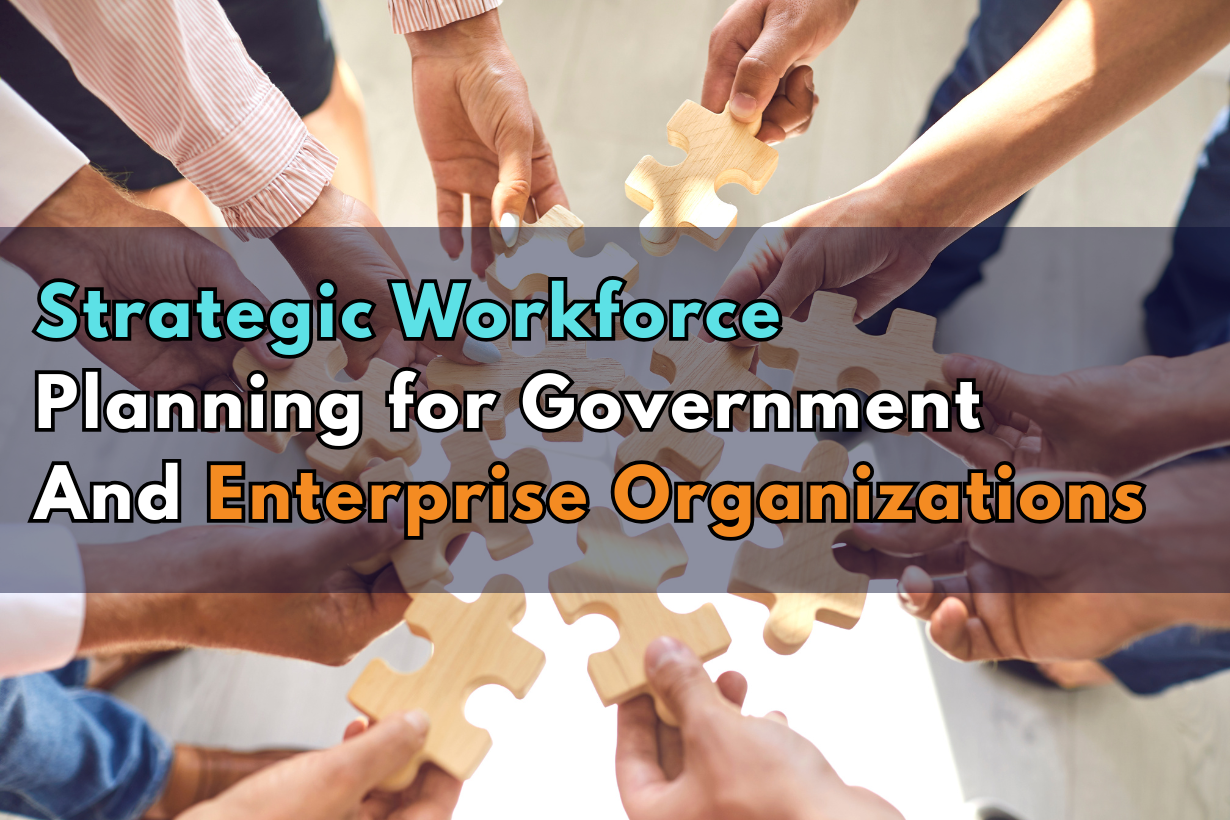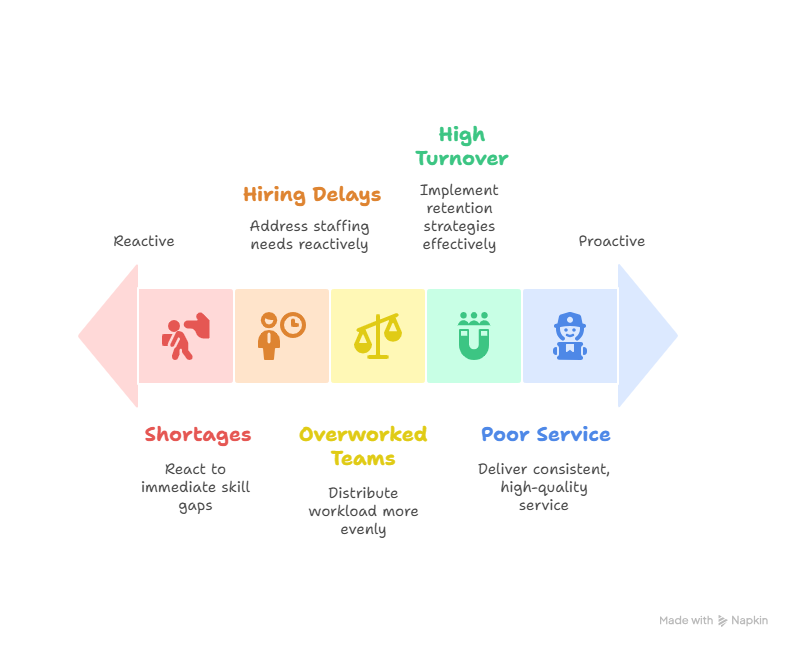
Strategic Workforce Planning for Government and Enterprise Organizations
- by Indu Sharma
When you’re trying to build a strong, future-ready organization, whether it’s a government department or a private enterprise, there’s one big question you need to ask: Do we have the right people in the right roles at the right time?
That’s what workforce planning is all about. And for both government and enterprise sectors, it’s the key to staying competitive, responsive, and prepared in a world that’s constantly changing.
Let’s walk through what strategic workforce planning in government and enterprise organizations really means, why it matters, and how you can get started.
What Is Strategic Workforce Planning?
In plain terms, strategic workforce planning is about understanding where your organization is today, where it’s going tomorrow, and what kind of people and skills you’ll need along the way.
Think of it like preparing for a long journey. You check your destination, figure out what you’ll need, identify any gaps in your plan, and make sure you’ve got the right people on board. That’s exactly what workforce planning does, only instead of snacks and maps, you’re working with skills, job roles, and future hiring needs.
In large organizations, especially in governmen,t it’s even more vital. These entities handle critical services, deal with complex systems, and are accountable to the public. Having a people strategy in place ensures everything runs smoothly, even when things change fast.
Why Workforce Planning Matters More Than Ever
Here’s the reality: the workplace is changing quickly. Technology, automation, aging workforces, shifting demographics, and evolving public needs are transforming how teams operate.

If you don’t plan ahead, you could face:
- Shortages of key skills when experienced staff retire
- Hiring delays or missteps
- Teams that are overworked or unbalanced
- High turnover rates
- Poor service delivery and a loss of public trust
On the flip side, smart workforce planning helps you:
- Predict staffing needs before they become urgent
- Upskill your existing team to meet future demands
- Hire proactively, not reactively
- Keep employees engaged with clear career paths
- Deliver better outcomes with fewer resources
Government Workforce Planning: Unique Challenges, Practical Solutions
Government departments face some challenges that are quite different from those in the private sector. Think tight budgets, lengthy hiring processes, shifting policies, and the pressure of public accountability.
Still, strategic workforce planning for government can be incredibly effective when approached the right way:
- Align Talent with Public Priorities – Identify which roles are most essential for delivering public services, and focus your resources there.
- Prepare for an Aging Workforce – Many public agencies have large segments of employees approaching retirement. Workforce planning helps you train successors and avoid disruptions.
- Stay Agile Amid Change – Whether it’s a new government, a policy shift, or a public health crisis, a well-planned workforce can adapt faster and continue delivering services.
- Build Internal Capability – Instead of relying on costly external consultants or contractors, forecast your needs and develop talent from within.
Workforce Planning for Enterprises: Staying Ahead of the Curve
In the business world, change is constant. New competitors, changing customer demands, and evolving technology mean companies must be quick on their feet.
Enterprise workforce planning enables companies to:
- Anticipate and prepare for future skills
- Develop leadership pipelines
- Reduce turnover and hiring costs
- Align people strategies with business goals
- Make smarter, data-informed decisions
Whether you’re a startup scaling quickly or a global company managing thousands of employees, workforce planning gives you the clarity to grow sustainably.
Getting Started: A Simple Framework
Not sure how to begin? Here’s a five-step guide:
- Assess Your Current Workforce – Understand your people—what roles they fill, what skills they have, and where the gaps are.
- Define Your Future Needs – Align workforce planning with your strategic goals. What’s changing? What skills or roles will you need tomorrow?
- Identify the Gaps – Spot areas where your current team won’t be enough, due to retirements, new initiatives, or evolving technology.
- Build a Strategic Plan – Develop hiring, training, succession, and retention strategies to bridge those gaps.
- Review and Adjust Regularly – Workforce planning isn’t a one-time project. Revisit your plan frequently to stay on track.
Tech Tools That Can Help
You don’t need to go it alone. There are powerful tools and technologies that make workforce planning easier and more effective.
Some of the best tools help you:
- Track employee data and skills
- Predict retirements or turnover
- Map out succession plans
- Analyze training and hiring needs
- Create dashboards and reports for leadership
At Mount Talent Consulting, we use a mix of these tools and our deep industry expertise to help organizations plan smarter and stay future-ready.
Real-World Example: Making It Work
Let’s say a city’s transportation department knows a big chunk of its maintenance staff will retire within five years. Instead of scrambling later, they use workforce planning to:
- Forecast staffing shortfalls
- Start apprenticeships now to train replacements
- Shift senior workers into mentoring roles
- Maintain consistent service for the public
The result? No disruption, better morale, and a more efficient system.
Final Thoughts
Strategic workforce planning for government and enterprise organizations isn’t a luxury it’s a must-have. It helps you stay ready for whatever the future brings, while keeping your teams strong, skilled, and motivated.
At Mount Talent Consulting, we specialize in making workforce planning clear, actionable, and tailored to your unique needs. Whether you’re a public agency or a fast-moving enterprise, we’ll help you design a strategy that works today and grows with you tomorrow.
Want to future-proof your workforce? Let’s start the conversation.
Frequently Asked Questions
Q1: Is workforce planning only for big companies or agencies?
No! Even small teams benefit from planning. It’s about making the most of your people no matter your size.
Q2: How often should we update our workforce plan?
At least once a year, or whenever a major shift happens like new tech, a leadership change, or policy updates.
Q3: Can workforce planning help reduce costs?
Definitely. It helps avoid bad hires, unneeded positions, and costly turnover.
Q4: Will it improve employee satisfaction?
Yes. When employees see there’s a plan for their growth and development, they feel valued and stay longer.
When you’re trying to build a strong, future-ready organization, whether it’s a government department or a private enterprise, there’s one…
